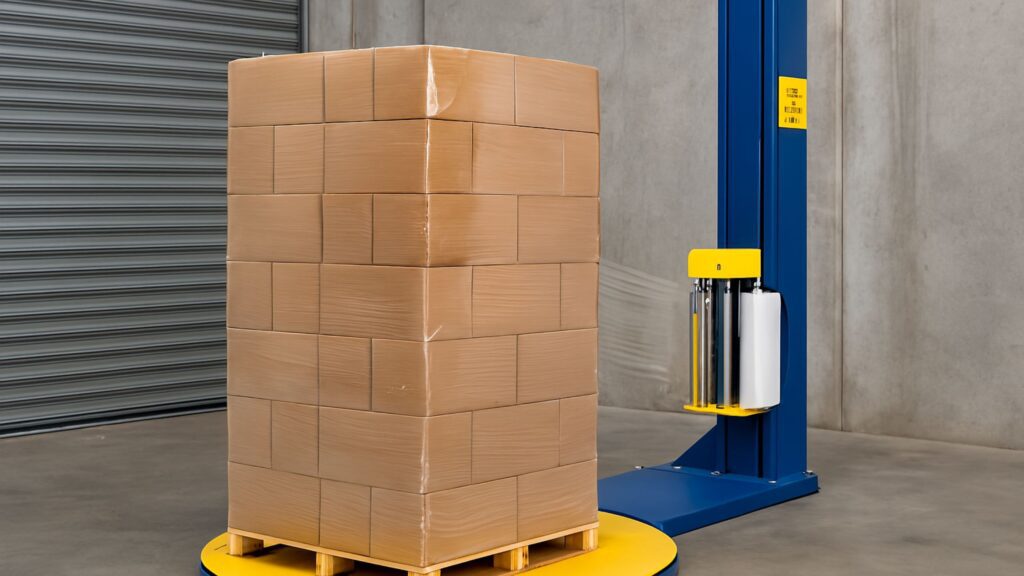In the fast-paced world of logistics, warehousing, and manufacturing, ensuring the stability and security of palletized goods is crucial. One of the most effective solutions for this task is the use of pallet wrap machines. These machines streamline the wrapping process, providing efficiency, cost-effectiveness, and consistency. In this comprehensive guide, we will explore everything you need to know about pallet wrap machines, their types, benefits, and how to choose the best one for your business.
What Are Pallet Wrap Machines?
Pallet wrap machines, also known as stretch wrap machines, are devices used to wrap plastic film around palletized goods to secure them for transportation or storage. The primary goal of these machines is to stabilize loads, prevent shifting during transit, and protect products from dust, moisture, and damage.
Traditionally, stretch wrapping was done manually, which is time-consuming and inconsistent. Pallet wrap machines automate the process, ensuring uniformity and efficiency while reducing material waste and labor costs.
Types of Pallet Wrap Machines
There are several types of pallet wrap machines available, each designed to meet different operational needs. The main types include:
1. Manual Pallet Wrap Machines
Manual pallet wrap machines require human intervention to operate. These machines assist the operator in applying stretch film but do not automate the wrapping process completely. They are ideal for small businesses with low-volume wrapping requirements.
2. Semi-Automatic Pallet Wrap Machines
Semi-automatic pallet wrap machines require some operator input but significantly reduce manual labor compared to fully manual methods. The operator places the pallet on the turntable and starts the wrapping cycle. These machines are suitable for medium-sized businesses with moderate wrapping needs.
3. Fully Automatic Pallet Wrap Machines
Fully automatic pallet wrap machines require minimal human intervention. They are integrated into conveyor systems and automatically wrap pallets as they move through production lines. These machines are perfect for high-volume operations, such as large distribution centers and manufacturing plants.
4. Rotary Arm Pallet Wrap Machines
Rotary arm pallet wrap machines have a rotating arm that moves around a stationary pallet, applying the wrap. This type is beneficial for wrapping unstable or very heavy loads that may not be suitable for turntable machines.
5. Orbital Pallet Wrap Machines
Orbital pallet wrap machines are designed for wrapping long or irregularly shaped loads. The film is applied as the load passes through a rotating ring. These machines are commonly used for securing pipes, doors, and lumber.
Benefits of Using Pallet Wrap Machines
Investing in a pallet wrap machine offers numerous advantages, including:
1. Increased Efficiency
Pallet wrap machines significantly reduce the time required to wrap pallets, increasing productivity and allowing workers to focus on other tasks.
2. Consistency and Load Stability
Machines apply stretch wrap evenly and consistently, ensuring uniform load containment. This reduces the risk of product damage during transit.
3. Cost Savings
By automating the wrapping process, businesses save on labor costs. Additionally, pallet wrap machines optimize film usage, reducing material waste.
4. Enhanced Load Protection
Proper wrapping prevents dust, moisture, and contamination from affecting goods. It also protects against tampering and theft.
5. Reduced Workplace Injuries
Manual wrapping can lead to repetitive strain injuries. Using a pallet wrap machine minimizes physical effort and improves workplace safety.
How to Choose the Right Pallet Wrap Machine
Selecting the right pallet wrap machine depends on several factors. Here’s what to consider:
1. Volume of Wrapping
Determine how many pallets you need to wrap daily. For small businesses, a semi-automatic machine may suffice, whereas high-volume operations benefit from fully automatic systems.
2. Load Size and Weight
Heavy or irregularly shaped loads may require a rotary arm or orbital wrap machine instead of a standard turntable model.
3. Film Type and Stretching Capabilities
Different machines have varying film stretching mechanisms. Pre-stretch film machines help reduce film usage and improve load containment.
4. Available Space
Consider the amount of space available in your facility. Some machines, like rotary arm models, require more room compared to compact turntable machines.
5. Budget
While automated systems offer higher efficiency, they also come with a higher upfront cost. Weigh the long-term benefits against the initial investment to determine the best fit.
Maintenance and Best Practices
To ensure optimal performance and longevity of your pallet wrap machine, follow these maintenance tips:
- Regular Inspections: Check for wear and tear on moving parts and replace damaged components promptly.
- Keep It Clean: Dust and debris can affect machine performance. Regularly clean sensors, rollers, and film dispensers.
- Lubrication: Keep rotating and moving parts well-lubricated to prevent friction and damage.
- Training Operators: Ensure workers understand how to operate the machine correctly to avoid misuse and accidents.
Conclusion
Pallet wrap machines are an essential investment for businesses involved in logistics, warehousing, and manufacturing. By automating the stretch wrapping process, they enhance efficiency, reduce costs, and improve load stability. Whether you opt for a manual, semi-automatic, or fully automatic machine, selecting the right model for your specific needs will optimize your operations and safeguard your goods during transit.
If you’re considering a pallet wrap machine for your business, assess your requirements, budget, and space constraints to make the best choice. With the right equipment, you can streamline your workflow and improve the overall efficiency of your supply chain.
Related Articles
- Case Erectors: Streamlining Packaging Operations for Efficiency and Growth
- Vacuum Pack Machines: Benefits, Types, and How to Choose the Best One
- Stretch Wrap Machines: Benefits, Types, and How to Choose the Right One
- The Ultimate Guide to Packaging Machines: Types, Benefits, and Applications
- Primary Packaging and Secondary Packaging: Understanding Their Roles in Product Protection and Marketing
- Functional Secondary Packaging: Enhancing Efficiency, Protection, and Branding
- Understanding Food Secondary Packaging: Importance, Types, and Benefits
- Pharma Secondary Packaging: Importance, Types, and Best Practices
- The Role of Secondary Packaging Equipment in Modern Manufacturing
- Sustainable Secondary Packaging: A Key to Greener Supply Chains

